ACUFO-1945-00-00-JAPAN-3
In the bulletin Air Intelligence Report, secret at the time, of the XXIst Bomber Command of the U.S. Army Air Forces, Volume 1, No. 8, pp 12-14, of April 26, 1945, an article was published headlined «Balls of Fire», preceded by an article presenting the piloted suicide rocket plane «Baka» aka «Viper» which the Japanese had planned to use as a flying bomb in “Kamikaze” missions. Several “Baka” had just been seized and studied.
The article on the «Balls of Fire» discussed whether or not this craft could explain the “balls of fire” reported by B-29 crews during their bombing raids on Japan in 1945.
Twelve examples of «Balls of Fire» sightings were cited; unfortunately, usually without date or location or information on the unit involved.
Case «2», actually two separate observations, included the following information on the first one:
A red ball of fire was seen dropping slowly from 1,000 feet to 500 feet below and ahead of one B-29. Then it dropped like a bullet and exploded on the ground.
The Air Intelligence did not estimate this report was in the several more puzzling cases; they commented that this sighting had "the characteristics of rocket projectiles launched from enemy aircraft."
| Date: | 1945 |
|---|---|
| Time: | |
| Duration: | |
| First known report date: | April 26, 1945 |
| Reporting delay: | Hours, months. |
| Country: | USA |
|---|---|
| State/Department: | |
| City or place: | Japan |
| Number of alleged witnesses: | 1 or more. |
|---|---|
| Number of known witnesses: | ? |
| Number of named witnesses: | 0 |
| Reporting channel: | Military Air Intelligence Summary report. |
|---|---|
| Visibility conditions: | ? |
| UFO observed: | Yes. |
| UFO arrival observed: | ? |
| UFO departure observed: | Yes. |
| UFO action: | Slowly descends then falls fast and explodes. |
| Witnesses action: | |
| Photographs: | No. |
| Sketch(s) by witness(es): | No. |
| Sketch(es) approved by witness(es): | No. |
| Witness(es) feelings: | ? |
| Witnesses interpretation: | ? |
| Sensors: |
[X] Visual: 1 or more.
[ ] Airborne radar: [ ] Directional ground radar: [ ] Height finder ground radar: [ ] Photo: [ ] Film/video: [ ] EM Effects: [ ] Failures: [ ] Damages: |
|---|---|
| Hynek: | ? |
| Armed / unarmed: | Armed, 12 Browning M2 12,7 mm machine guns. |
| Reliability 1-3: | 2 |
| Strangeness 1-3: | 2 |
| ACUFO: | Probable rocket or air-to-air bomb. |
[Ref. aaf2:] U.S. ARMY AIR FORCES:
After a presentation of the “Baka” aka “Viper” piloted rocket suicide bomb (see my Discussion section), a chapter title “Are these fireballs?” expanded on whether this craft was the “balls of fire” reported by B-29 pilots in the Pacific in 1944 - 1945.
12 examples of reports of “balls of fire” are cited; unfortunately, generally without date or location or information on the involved unit.
The introduction read:
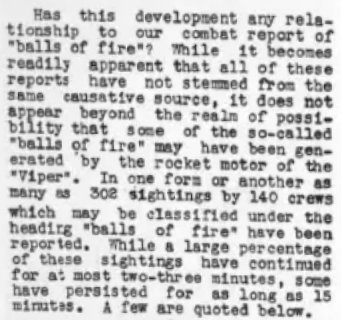
|
Has this development [the “Baka” aka “Viper”] any relationship to our combat reports of “balls of fire”? While it becomes readily apparent that all of these reports have not stemmed from the same causative source, it does not appear beyond the realm of possibility that some of the so-called “balls of fire” may have been generated by the rocket engine of the “Viper”. In one form or another as many as 302 sightings by 140 crews which may be classified under the heading of “balls of fire” have been reported. While a large percentage of these sightings have continued for at most two-three minutes, some have persisted for as long as 15 minutes. A few are quoted below.
Quoted below were indeed 12 reports summaries, including:
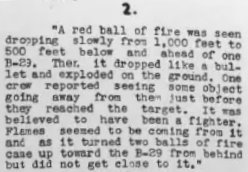
|
“A red ball of fire was seen dropping slowly from 1,000 feet to 500 feet below and ahead of one B-29. Then it dropped like a bullet and exploded on the ground. One crew reported seeing some objects going away from them just before they reached the target. It was believed to have been a fighter. Flames seemed to be coming out from it and as it turned two balls of fire came up toward he B-29 from behind but did not get close to it.”
The reports were followed by these comments:
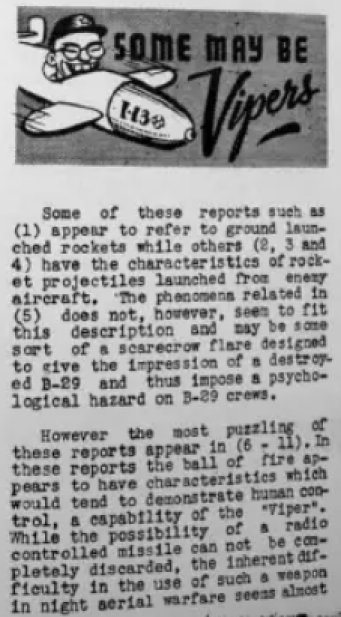
|
Some of these reports such as (1) appear to refer to ground launched rockets while others (2, 3 and 4) have the characteristics of rocket projectiles launched from enemy aircraft. The phenomena related in (5) does not, however, seem to fit this description and may be some sort of a scarecrow flare designed to give the impression of a destroyed B-29 and thus impose a psychological hazard on B-29 crews.
However the most puzzling of these reports appear in (6 - 11). In these reports the ball of fire appears to have characteristics which would tend to demonstrate human control, a capacity of the "Viper". While the possibility of a radio controlled missile ca not be completely discarded, the inherent difficulty in the use of such a weapin night aerial warfare seems almost
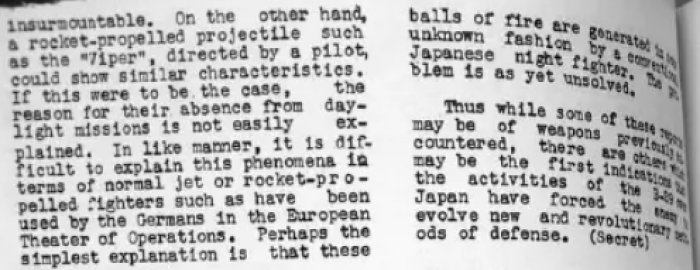
|
insurmountable. On the other hand, a rocket-propelled projectile such as the “Viper”, directed by a pilot, could show similar characteristics.
If this were to be the case, the reason for their absence from daytime missions is not easily explained. In like manner, it is difficult to explain this phenomena in terms of normal jet or rocket-propelled fighters such as have been used by the Germans in the European Theater of Operations. Perhaps the simplest explanation is that these balls of fire are generated in an unknown fashion by a conventional Japanese night fighter. The problem is as yet unsolved.
Thus while some of these reports may be of weapons previously encountered, there are others which may be the first indications that the activities of the B-29 have forced the enemy to evolve new and revolutionary methods of defense. (Secret)
The plane involved in this observation is not specified in the [aaf2] report; however, all the sighting reports presented in this source related to sightings by B-29s crews of the XXIst Bomber Command.
The Boeing B-29 “Superfortress” was the heaviest bomber of the U.S. Army Air Forces, used in operations from May 8, 1944 and on. Its maximum speed was 574 km/h.
Its defensive armament was 12 Browning M2 12.7 mm machine guns.
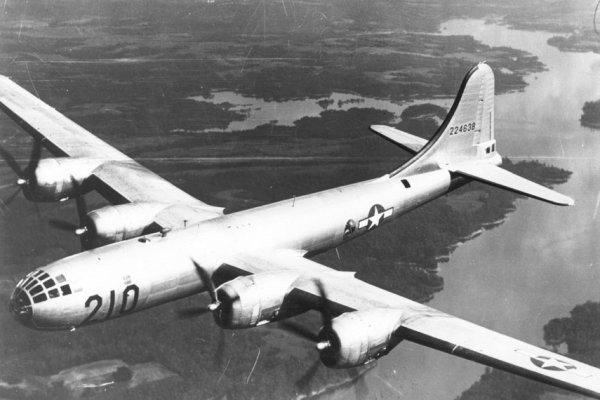
|
The location of this sighting is not specified in the [aaf2] report; however, all the sightings in this source occurred during bombing raids over Japan in 1945.

|
It is in no way certain that this observation, since it was combined with another one, was considered the least strange by the Air Intelligence.
It can be considered probable that for the Air Intelligence it was part of the possible rockets fired by enemy planes; and nothing formally opposes such an explanation. It could also have been an air-to-air bomb dropped by an enemy aircraft in front of the B-29s, but too early since it would appear to already be lower than the B-29 or B-29s when it was seen. The thing then fell to the ground and exploded. This makes the idea that it would be some extraterrestrial craft rather absurd.
Below, I provide a report about air-to-air bombs, also during a B-29 raid on Japan in 1945, taken from the mission's tactical report:
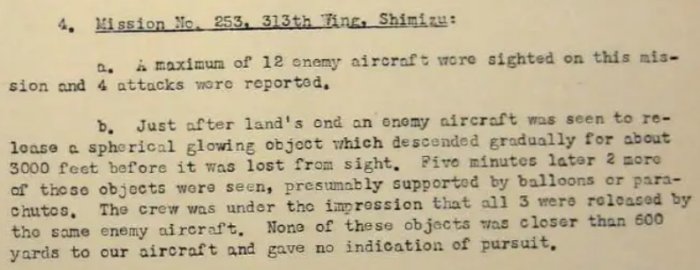
|
4. Mission No. 253, 313th Wing, Shimizu:
a. A maximum of 18 enemy aircraft were sighted on this mission and 4 attacks were reported.
. Just after land's end an enemy aircraft was seen to release a spherical glowing object which descended gradually for about 3000 feet before it was lost from sight. Five minutes later 2 more of these objects were seen, presumably supported by balloons or parachutes. The crew was under the impression that all 3 were released by the same enemy aircraft. None of the objects was closer than 600 yards to our aircraft and gave no indication of pursuit.
A “Baka” seems unlikely here since the “ball of fire” is reported to have descended 500 feet “slowly”, and the action of this supposed “Baka” would have been totally useless.
Probable rocket or air-to-air bomb.
* = Source is available to me.
? = Source I am told about but could not get so far. Help needed.
| Main author: | Patrick Gross |
|---|---|
| Contributors: | None |
| Reviewers: | None |
| Editor: | Patrick Gross |
| Version: | Create/changed by: | Date: | Description: |
|---|---|---|---|
| 0.1 | Patrick Gross | July 18, 2024 | Creation, [aaf2]. |
| 1.0 | Patrick Gross | July 18, 2024 | First published. |